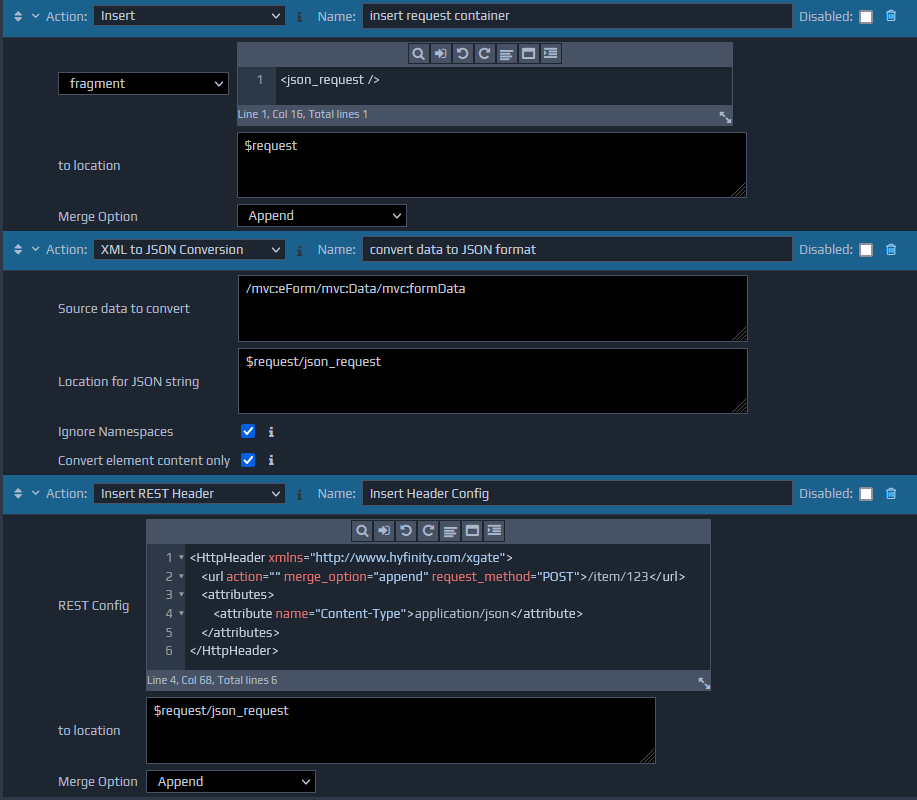Setting up a REST Service Call
First open the Controller Rules for the controller that will be making the call to the REST service. If you don't yet have a controller, then create one from the Application Map.
Now add an Invoke Service action to a rule, and chose the Call a REST Service option. If you have not yet set up any REST services in this project the dropdown in the Select Target Service popup will be empty, so click the Create New REST Call link.
This new window will ask for the URL of the target service, and a Friendly Name to use for it within your project.
 Once a URL has been provided, a guess will be made at the Friendly Name, but this can be adjusted as required. If you will be making multiple calls to this service, then ensure you enter the base URL that is common to all of them. The final URL called each time can be adjusted using the REST config discussed below.
Once imported, the Invoke Service rule action will now be correctly populated. If you wish to call this service from other Rules and Controllers, you will simply need to select it from the Call Existing REST Service dropdown.
Once a URL has been provided, a guess will be made at the Friendly Name, but this can be adjusted as required. If you will be making multiple calls to this service, then ensure you enter the base URL that is common to all of them. The final URL called each time can be adjusted using the REST config discussed below.
Once imported, the Invoke Service rule action will now be correctly populated. If you wish to call this service from other Rules and Controllers, you will simply need to select it from the Call Existing REST Service dropdown.
Customizing the Runtime Call Behaviour
An HttpHeader fragment can be used to dynamically set http header attributes and direct payloads to dynamically constructed URLs.This fragment should be included in the request payload to be sent for the External Call.
The Insert REST Header rule action provides an easy way to setup this fragment, and should be used before the Invoke Service action. The Insert REST Header action provides a fragment like below, which can be adjusted as required. If you need to dynamically set any of these values, then you would use Assign actions after the Insert REST Header as required.
<xg:HttpHeader xmlns="http://www.hyfinity.com/xgate" xmlns:xg="http://www.hyfinity.com/xgate">
<xg:url action="" merge_option="append" request_method="GET">/service/url</xg:url>
<xg:params>
<xg:param name="command">login</xg:param>
<xg:param name="error_dest">client</xg:param>
</xg:params>
<xg:attributes>
<xg:attribute name="HTTPHeaderAttrib1">attribute value</xg:attribute>
<xg:attribute name="HTTPHeaderAttrib2">attribute Value</xg:attribute>
</xg:attributes>
</xg:HttpHeader>
URL attributes
@action - If a non-empty string value is specified then this overrides the static action specified by default in the Invoke Service rule configuration. If an empty string value is specified then this still overrides the static action that is specified during deployment and sets the action header attribute with an empty string. If this attribute is missing then the static action value will not be overridden. If you do not want an action HTTP Header to be set at all, then set this attribute to the value NONE.
@merge_option - options are
The params will be appended to the URL in replaceor
append. When set to
replacethe static url specified during web service set-up will be replaced by the URL found in the HttpHeader fragment at runtime. If the
appendoption is specified then the static url supplied will have the dynamic url in the HttpHeader fragment appended to it. @request_method - The HTTP request method to fire. This can be one of the strings
GET,
POST,
PUTor
DELETE. If a value is not supplied or an empty string is supplied then the default will be
POST.
name=valuepairs separated by "&" after a "?" has been inserted between the URL and the params. e.g. http://anyValidUrlString?command=login&error_dest=client The attributes will be set in the request http header before a request is made to the URL. The name attribute indicates the name of the http header attribute and the value is the value to be set for this header attribute.
Dealing with JSON Data
If your service deals with JSON formatted data, then you can use additional rule actions to convert the JSON string to XML, and vice versa.
If your service returns a JSON response, then the JSON string will be available in your Controller rules within a non_xml_content element in the service response. To convert this into a structured XML format for easy binding to page fields you would use a JSON to XML Conversion action.
 If you are trying to post a JSON request to a service then you will need to configure the HTTPHeader as described above so that a
If you are trying to post a JSON request to a service then you will need to configure the HTTPHeader as described above so that a Content-Typerequest header of
application/jsonwill be set. The XML data to be sent should be converted to JSON using an XML to JSON conversion action, and placed within a
json_requestelement. The HttpHeader fragment should also be placed within the json_request before this element is sent to the Rest Service Proxy.
